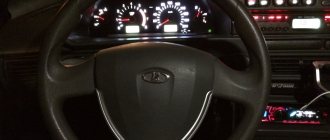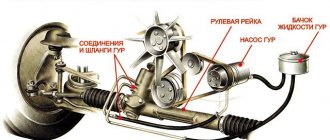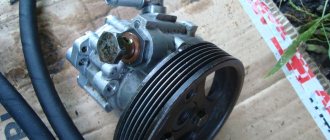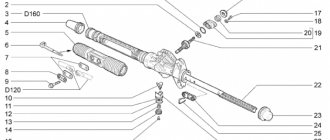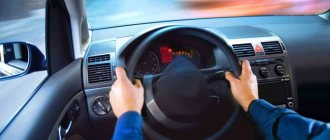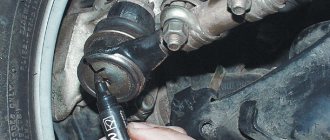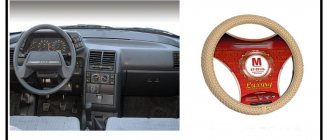Unfamiliar sounds made by the car when the steering wheel is turned (and this can be knocking, creaking, rumble, rattle, hum, etc.) do not yet mean the occurrence of a malfunction that must be eliminated. For example, cars with power steering sometimes make a very loud noise when turning the steering wheel (this is one of the specific features of some power steering). On the other hand, if instead of a hum you can clearly hear a squeak or, even more so, a knock, then it’s time not to rely on chance, but to stop by a car repair shop.
A very important thing when diagnosing a car will be whether you are able to clearly describe the nature of the sound during a turn - squealing, crunching, rumble, grinding, etc. Below we will look at the most common symptoms of such sounds and give you recommendations on how to eliminate the noise. However, you better be prepared in advance for the fact that the service master may ask you a number of things to which it would be better to answer - this will help him understand the problem. If possible, prepare answers to the following questions regarding steering noise:
- The type of sound produced (rumble/grind/crunch, etc.).
- Is the sound heard when turning the steering wheel, or under some other conditions?
- How do weather conditions, heating of steering system or suspension elements, weather, vehicle load, etc. affect the resulting sound?
- Does the car make noise when it spins in both directions or in one direction?
- Auxiliary signs or phenomena that occur with this noise.
If you are able to answer questions like these, identifying the problem and the cause of the noise will be much easier.
The front part of your car takes on a lot of different functions:
- prevents the car from leaning sideways when cornering;
- allows the wheelset to move up and down to dampen loads;
- control the direction of movement of the car using the steering wheel;
- transmits engine power to the wheels, giving the car acceleration (front-wheel drive).
As you can see, there are many factors that can influence the reduction in the service life of the elements of the front suspension and steering system. But not everything is so bad - many elements whose life is ending seem to warn the driver with strange sounds: “lubricate me,” “replace me,” “fix me.” True, such warnings almost always mean that the “screaming” part is already on the verge of wear or failure - therefore, it is highly recommended not to delay diagnostics. After all, some sounds sound like grinding, others like creaking, etc.
Below we will look at a number of typical sounds a car makes when the steering wheel is turned, as well as the factors that cause such noises. This is where the breakdown should be identified. Of course, this list is far from complete. In general, let's start the review, so read and remember well.
Rumble (steering wheel turns, car stops)
Typically, this sound is produced by the hydraulic booster, which is installed on many cars. And there is nothing scary about this noise. When you get into the car, you may feel this sound - now you know that it will appear regularly. It is extremely rare that such a sound is detected when the steering wheel is turned in only one direction.
It seems that you have become accustomed to this sound, the car has been used for a long time, but the hum becomes louder and more distinct - now it can be heard not only when turning the steering wheel in the absence of movement, but also while driving. Here, be sure to try diagnosing the power steering. The most common cause of such noise is a lack of special power steering fluid, so the problem is often solved when such fluid is added to the power steering reservoir located under the hood (it is marked with MIN and MAX marks, they mean the maximum and minimum amount of fluid). Obviously, at the MIN level, fluid is most likely leaking from the system, so after topping up, you will need to check this level for some time (at least once a week).
The noise may also be caused by a breakdown of the power steering pump, weak tension of the power steering belt, as well as air flow that has penetrated into the power steering circuit. Alas, in all these cases you should definitely contact a car repair shop.
As a rule, problems with power steering are almost always accompanied by the need to apply more force than usual to turn the steering wheel.
Chip errors
When a situation is observed that the wheels turn on their own, the reason is the electronic filling of the Priora electric power steering control unit.
As mentioned above, quality was sacrificed for the sake of economy. Now the situation with this seems to have improved and everything has been finalized, but if suddenly you feel that the steering wheel is starting to move by itself, go for repairs. If, along with the electric power steering, the speedometer also fails, then you need to look at the speed sensor. It was either simply dirty or broken. The same applies to the torque sensor installed on the amplifier. Clean them well and check their functionality.
Knock (steering wheel turns, car turns)
This kind of sound accompanies the car when turning. It is noteworthy that often a small turning angle and a bad road make the car make such a knock more strongly. The reason for this behavior of the car is the wear of the shock absorbers, which no longer dampen road irregularities. In this case, only replacing with new racks will help. As a rule, the axle struts have different degrees of wear, so it is likely that a knocking noise is heard only when the steering wheel is rotated in only one direction.
A knock can occur not only when turning, but also when moving straight along a poor quality road. The maximum load on the racks occurs when the steering wheel is turned, which is why the knocking sound is produced more often. Just in case, check the strut housings - they may contain oil smudges, which indicates an oil leak in the struts.
A car with a decent mileage (the word “decent” means different numbers depending on the model), the shock absorbers can fail (due to various factors). It would be useful to find out how susceptible your car is to this disease either in the official service center or in the appropriate forum dedicated to your car brand. You can also immediately go to a specialist to diagnose the racks.
Steering knuckle bearings
If, when turning the steering wheel, the driver hears an uncharacteristic squeak, which can sometimes appear quite suddenly, it is worth listening to the steering knuckle.
When the sound comes from there, the cause most likely lies in worn bearings.
These bearings can squeak and make cracking noises if there is no lubricant inside or if sand or other abrasive contaminants have entered the housing.
Untimely replacement can have dangerous consequences. It is recommended to remove the bearing from the steering knuckle and check it for defects. If they are not there, lubricant is added and the part is returned to its place. If defects are detected, a new bearing similar to the previous one is used.
Knock (the steering wheel turns, but there is play)
Typically, the joints found in the steering system last as long as your car drives. However, under Russian operating conditions, faster wear is possible. Turning the steering wheel, accompanied by a faint knock at the beginning of rotation, indicates that the hinges are worn out (an increased gap has appeared). If you park the car on a level surface, then try to rotate the role from right to left, then from left to right (you need to start carefully with small movements), you can identify at what point in time the play and knocking sound appears. You can improve this method a little - open the car doors, then with the doors open, while outside the car, gradually turn the steering wheel from side to side. At some point in time, you will notice that the steering wheel rotates, but the wheels do not move - this means there is play. This backlash needs to be eliminated.
This can be done by diagnosing the hinges at a car repair shop (you need to check for wear and play), after which you need to replace the worn elements and tighten the necessary components that are causing the play.
When the shock absorber is faulty
Sometimes the cause of the noise is the creaking of the support bearing when turning the steering wheel. If creaking and howling noises occur no matter which way you turn, check the shock absorbers. Often the problem is in the bearings of this unit. It may be enough to remove any dirt that has clogged up under the boot. How to diagnose? Read on.
Try turning the steering wheel while standing still. Even better, ask an assistant to “steer”, while you listen and watch the movement of the shock absorber spring into the gap between the upper edge of the tire and the wing arch. If the part turns jerkily, as if something is interfering with it, it means that the support bearing creaks when turning the steering wheel. It's simple. There is no movement - neither the transmission nor the hubs can make noise - the shafts and wheels do not rotate. In this case, the only thing to suspect is the shock absorber struts.
Grinding, as well as squeaking (the steering wheel turns both when driving and when standing still)
A grinding/creaking sound that is felt when the steering wheel is turned in different directions. This noise occurs due to wear on the suspension joints or steering joints. Similar to the previous point, here you will need to diagnose the suspension components or steering system, replacing worn parts, if necessary.
However, the most common reason for such a sound is the lack of lubrication in the steering tips (as well as their severe wear).
Thanks for subscribing!
Sometimes such a squeak can even be accompanied by a crunching sound, regardless of whether the car is moving or standing still. In this case, the culprits are the lower ball joints (sometimes the shock strut bearings). The first option is also accompanied by play in the steering wheel when the car is suspended.
Other reasons
When the driver realizes that his steering wheel is creaking when turning, he begins to look for the cause. However, the malfunction may lie in different elements of the car system. Specific car brands have their own specific reasons, which are not discussed in this article. The variety of steering systems is so great that there are many causes of malfunction.
In any case, whatever the cause of the problem, it must be eliminated as soon as possible. And it will be good if a professional does this. It's best to see a mechanic as soon as you notice any warning signs that could indicate a problem with your power steering or other critical components. Underestimating minor problems can lead to their aggravation and complete destruction of the system, which is associated with expensive repairs.
Crunching sound (steering wheel turns when driving; car with front-wheel drive)
It happens that when the direction of movement of the car changes, a strong crunching sound is heard. The greater the turning speed and the narrower the radius, the more pronounced it is. There is a feeling that the steering wheel does not play any role here, and that it is the turn itself that is to blame, that the crunch is heard in the area of the loaded wheel (remember that this is the wheel from the outer radius of the turning curve). Most often, this picture is characteristic of turning only in one direction.
Only all-wheel drive vehicles or vehicles with front-wheel drive suffer from such problems. The culprit for this is the constant velocity joint, which in our country is called the “grenade”.
This hinge is a prefabricated element that serves to rotate the front wheel along any axes at a certain angle, without losing the constant speed of the axle. When the car moves, the CV joint rotates all the time, experiencing heavy loads. From time to time, this part runs out of service prematurely, in which case it will need to be replaced.
Checking the “grenade” looks like this. The steering wheel must be turned to one side all the way. After this, you should start moving the car in a circle - in one direction, then in the other. The crunching noise heard during such an operation means that the CV joint is the culprit. If there is vibration that may accompany such a crunching noise, the car must be taken to a professional mechanic without delay.
The so-called boot protects the CV joint from dirt and dust. Often, wear of the “grenade” occurs due to damage to the boot. Actually, the sound of a crunch means that either particles of sand or dirt have penetrated through the boot into the CV joint and the joint begins to grind it all, or the crunch is caused by the collapse of the bearings inside the CV joint.
The machine is not the simplest mechanism. Its steering system and suspension include a huge mass of elements. The suspension and steering differ in their functionality, design, and elements (and differences may appear from model to model; differences may even exist in modifications). For this reason, various noises do not need to be produced only for the reasons described above. For example, noise can be caused by the steering rack, steering column, steering knuckles, struts and joints. An old, falling-off element, which is not directly related to either the suspension or steering, can touch parts of the above systems during a turning maneuver or on road irregularities, causing noise.
In any case, the main thing you need to do when you hear an extraneous sound accompanying the turning of the steering wheel is to determine the other signs accompanying the noise (the car is pulling to the side, a more specific definition of noise). After this, it is necessary to check each boot of the suspension and steering systems, inspect the steering wheel, and check for play.
Reading time: 4 minutes
The driver of a car, turning the steering wheel, sometimes hears extraneous sounds coming from the front of the car. Sometimes they don’t mean anything, but in some cases, when you hear a grinding sound in the wheel area when turning the steering wheel, we are talking about serious problems.
Sounds on cars with hydraulic booster
The power steering mechanism consists of the same parts and trapezoids, only the rack has special oil channels. Through them, oil under pressure acts on the steering rods, which makes it easier to turn the wheels.
– wear of the impeller of the power steering pump itself;
– jamming of the power steering pump;
– broken boots in the steering rack (it will start to leak);
– wear of the power pump drive pulley.
This kind of trouble happens even when the steering is working properly. In a strong eversion of the wheels, the load on the power steering pump becomes large. Especially when the car is loaded. The sound occurs due to increased wear on the drive pulley or belt.
When turning the steering wheel, a grinding noise is heard in the wheel area
What could be the reason
When you hear squeaks, grinding noises, or crunching noises from a wheel when turning, this may be due to one of the following reasons:
- Due to long-term use, the steering rack wears out. It is possible that the noise is due to the fact that the fastening is loose.
- This result is caused by a faulty steering column.
- If the shock strut bearings need replacing or have bad ball joints, this is also a possible cause of the noise.
- The drive mechanism must operate in clean conditions, but if the anthers rupture, dirt will get inside and disrupt its operation.
Problems with the steering rack
The main reason for annoying squeaking noises when turning the steering wheel is a faulty steering rack. Such a squeak can be annoying, and untimely repairs can damage the parts. Unwanted squeaking can occur due to simple wear of the mechanisms, damage to the rack box or wear of the steering tips, which can rub against the rods. In addition, damaged anthers can accumulate dirt and debris, which makes a nasty sound when the mechanism operates.
Also, the cause of an unwanted squeak may be an incorrect setting between the steering rack and the column. It is extremely difficult to make such an adjustment, since all machines have an individual adjustment system, and it is better to trust a specialist.
What to do if you hear a grinding noise near the wheels on a VAZ-2114 when you turn the steering wheel
A similar grinding noise can be heard when there is a fault in the support bearings of the steering column.
It happens that the source of noise is in the wheels. In this case, there may be various reasons for the problem. Here are the most likely ones:
- Due to the rubber being torn, stones or crushed stones got into the outboard bearing of the cardan.
- This sound may occur due to friction of the brake pads against the discs.
- A loose retaining ring can be another possible cause of grinding noise.
- In cold weather, noise may occur if there is insufficient lubrication. If you add it additionally, the problem will disappear.
Not only the above reasons are possible here, but also other reasons.
Adviсe
If the sound you hear from the front of the car resembles a gurgling noise, the most likely cause is high wear on the tie rod ends. In this situation, it is not recommended to continue driving. Otherwise, there is a possibility that the steering control system will be damaged in this way.
Both of these tips are changed at the same time, and this entails significant financial expenses. After the repair, it will be necessary to adjust the wheel alignment.
Sometimes when driving there is a muffled knocking sound. In this case, it can be argued that the bearing is worn out and needs to be replaced.
Tie Rod Ends
Recommendations
When you hear a grinding sound from the front wheels, you need to try to more accurately determine the nature of the sound. One possible source could be a damaged plastic fender liner. Although the grinding noise may be loud, it is not dangerous and can be easily fixed.
You need to pay attention to exactly when the noise appears. If it started after the car overcame the hole, then it may be a problem with the shock absorber spring. It is recommended to replace this part. If the spring is welded together, it will not be as strong as before.
Noises from power steering
Despite the fact that electric power steering is being introduced very often today, the main driver assistant when steering in most passenger cars remains power steering. This unit may make noise due to a lack of working fluid. In this case, you need to add it to a tank specially designed for this purpose. Just add the same liquid that the manufacturer used, the amplifier itself is configured specifically for the operating parameters of a particular product, and the use of a different liquid can be very negatively perceived by the amplifier. In addition to the lack of working fluid, the cause of noise in the power steering can be its pump, if it is about to die, you also need to check the condition of the power steering belt, because certain difficulties can also arise with it. And if the condition of the power steering belt makes you suspicious, it is better to replace the belt.
: when braking in a car - why and what to do?
A clear creaking sound when turning the steering wheel - checking for possible problems
Before doing this, you need to clarify what is happening. To do this, you need to answer the following questions:
- It is necessary to more specifically determine what kind of noise is heard. To be clear, this refers to a squeaking, grinding, knocking or other sound.
- It is necessary to clarify the circumstances under which this occurs. Some possible answers to this question: while moving, while stopping, or in another case.
- How constantly does the noise occur and when: with any movement or only in some specific circumstances.
- It is necessary to find out whether the creaking occurs in the same way when turning in both directions or only occurs in one direction.
Various features of why the wheels squeak when turning and the malfunction that has occurred will enable car service specialists to repair the car.
Shock absorber spring burst
When you hear a creaking or crunching sound in the wheel area, it is necessary to determine its source and carry out repairs. In some cases, if you do not pay attention to the problem that has arisen, it will cause serious damage.
Crunching sounds when turning the steering wheel are not a common malfunction, so they can confuse car owners - many simply do not have experience in dealing with this scourge due to its rarity. Meanwhile, the phenomenon is very insidious. It is very dangerous to let the situation with the steering take its course, so when the first oddities (including sound ones) appear in its operation, you need to react. The problem is that the crunching has one obvious reason and many unobvious ones. It’s good if the problem can be fixed in an obvious way, because otherwise the cause of the squeak can take a long time to find.
Crunching noise when turning the steering wheel while driving
A striking feature of the “steering” crunch is whether it is heard only while driving or is heard while standing still. This classification allows you to choose the desired search direction. If a crunching sound is heard during turns and maneuvers in motion, then with a high degree of probability the problem is in the CV joint. Constant velocity joints allow you to shift the plane of torque transmission. Usually in a front-wheel drive car there are two pairs of them - the internal ones are located near the exit from the gearbox, and the external ones are located directly near the wheel and allow torque to be transmitted even when the wheels are turned out. It is when the steering wheel is turned at speed that a sharp sound appears, the frequency depending on the rotation of the wheels. It is difficult to confuse it with something else; drivers whose CV joints have started to creak at least once can easily recognize the breakdown the second time.
In general, the CV joint is a fairly simple and reliable design. Very rarely they die from natural wear and tear, and if this happens, it happens over very long runs, at least several hundred thousand kilometers. However, CV joints can fail at any mileage, even very little, the cause will be problems with the anthers.
A kind of rubber covers, designed to protect CV joints from dirt and water, either break due to contact with sharp stones, nails, wire and other debris scattered on the road, or fly off the mount. How long does a protected hinge last and how little does a hinge that gets dirt and water get into? Usually, it takes a little time from damage to the anther to a crunch. In theory, if you notice damage to the boot, but the CV joint has not yet crackled, then you can wash the assembly, lubricate it and cover it with a new boot, but rarely does anyone inspect the car at least weekly from a pit or a lift, so damage to the boot usually becomes obvious after The CV joint crunched. In the vast majority of cases, problems arise with external CV joints.
Elimination: tips and tricks
Eliminating the causes of noise depends on the cause. If the noise is caused by damage to the tie rod boots, first remove the dirt accumulated in the mechanisms - VD-40 is used for this purpose. On damaged CV joints, new boots must be installed.
If the wheel alignment angle is abnormal, you can straighten the locker and drive to the nearest service center. And you can find and remove creaking caused by friction of plastic interior elements yourself.
Any power steering malfunction, including damage to the pump, must be repaired by a service center. Eliminating the main causes of squeaking on your own is extremely difficult and often pointless. It is much easier and faster to get help from specialists who are well versed in the design of a particular machine.
Diagnosis of EUR malfunction
First of all, the main symptom of a malfunction appears in the form of a steering wheel icon with an exclamation mark on the Priora’s instrument panel. In this way, the ECU notifies the driver of problems with the power steering.
Normally, when the ignition is turned on, this icon lights up for a while and then goes out. However, if the system is faulty, the icon indicating that the Priora's electric booster is faulty will be constantly on.
As for the most common problems, the EUR power wires (red and black) may become loose or burnt. The power steering fuse also often fails. By the way, voltage drops may not be related to the amplifier. In this case, you need to check the condition of the battery and the functionality of the generator.
Let's move on. It also happens that the steering wheel icon on the panel does not light up, but the driver still notices that the EUR on the Priora does not work as it should. To quickly check, you need to turn the steering wheel with the ignition off, remembering the force. Next, start the engine, and then check the force. If the force is the same both when the engine is turned off and when the engine is running, then there is reason to believe that there are problems with the electric booster.
Battery problems
Based on this, we can draw the first conclusions about the cause of the breakdown. A common cause of malfunction is low voltage in the on-board network. The fact is that for the amplifier to function, a supply voltage of 13.5V is required.
First of all, we test the battery, if everything is fine with it, then we’ll look into it further. The problem may have occurred when you removed the battery for charging. To make the electric booster work again, turn the wheels to the extreme position and back 5-6 times, very often this is enough to resume operation.
Major failures of the EUR
Experienced drivers and Prior owners can observe the following trend - breakdowns occur in the same parts, weak points of the system. Why is this happening?
The first thing you need to pay attention to is the operation of the electric power steering. After the system has been completely turned off, a code should appear on the on-board computer - it reports the cause of the breakdown. Each code has its own interpretation. However, very often the real reason for the cessation of operation of the amplifier can be determined only after a full diagnosis has been carried out. In order to find out about the nature of the breakdown of the Lada Priora electric power steering, do the following:
- The engine is turned off and the steering wheel is turned a couple of times.
- The engine turns on and the steering wheel turns several times.
It is quite possible to drive with the system turned off, but it is not recommended. It is very difficult to understand the features of control with and without an electric booster. Therefore, it is better to perform a diagnosis. It will help determine which component has failed, whether it can be repaired or whether it is better to replace it with a new one.
Sometimes you can observe the following situation: the speedometer and the sensor stop functioning at the same time. This most often occurs due to a malfunction of the speed sensor. The sensor provides data to the control unit, which processes the information on the speedometer and determines the supply of the required amount of force.
If the cause of the breakdown is the sensor, the solution to the problem is simple. It is enough to check the quality of the wires and, if necessary, replace them with new ones. If the wires are in good condition, it is recommended to replace the sensor itself.
Fuse removal process
If, during smooth and smooth movement forward, the car turns sharply to the side, it is recommended to carry out unscheduled diagnostics. After all, such unpredictable behavior of the Priora’s electric power steering will not happen without emergency situations. Park and unplug the unit: Disconnect the fuse to stop power supply to the amplifier.
To remove the fuse, you need to do the following:
A car malfunction indicates problems with the ESD. There can be many reasons for this, the breakdown of one part or several. To determine the cause as accurately as possible, seek specialized diagnostics. And you can replace or repair a damaged part yourself.
The process of removing the electric amplifier
If you decide to replace the electric power steering on a Prior car or make sure that its individual parts are in working condition, you need to remove the unit completely. For this you will need:
- chisel;
- head for 8 or 13;
- extension;
- ratchet.
The process of removing the EUR is simple and fast. The process is lengthy: you need to remove the steering wheel, grab the airbag, then remove the cover and finally, the ignition switch. After all this, you can take out the electric amplifier.
Repairing the EUR on-board computer
As for the “brain” and internal sensors, the procedure is as follows: to fix broken sensors, it is better to go to a service station, but you can change the computer at home. Tools that need to be used to work with the equipment:
- socket wrench 8;
- socket wrench 13;
- shaped screwdriver.
It is necessary to first remove the steering wheel.
